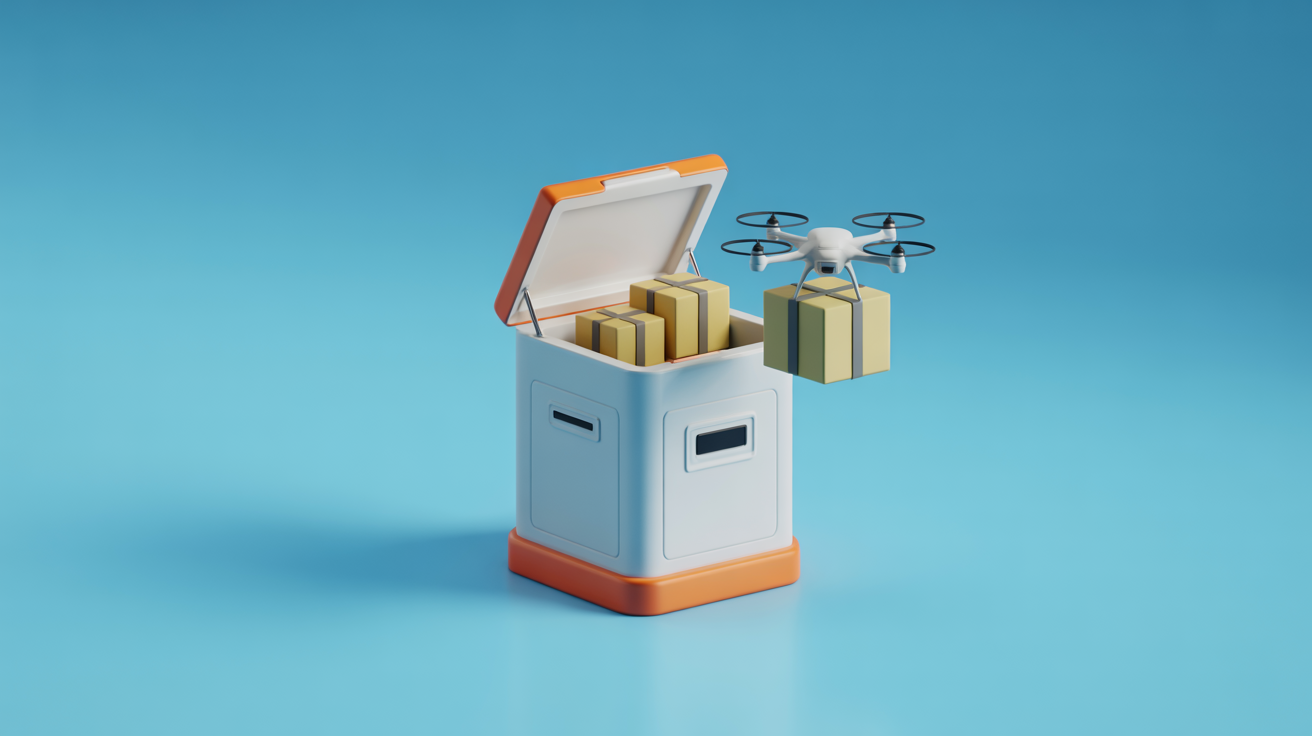By Futurist Thomas Frey
For over a century, the humble mailbox has barely changed. A metal box by the curb or a slot in the door has served as the final checkpoint of global commerce. Letters, bills, and eventually Amazon packages all end up in the same simple container. But as drones, delivery robots, and autonomous couriers take flight, that old mailbox suddenly looks obsolete.
The future of delivery isn’t just about drones. It’s about the infrastructure that supports them—and companies like Arrive AI and Valqari are betting big on a new age of “smart mailboxes” designed to handle packages from air, land, and everything in between.
Why the Mailbox Needs an Upgrade
The logistics industry has poured billions into automating warehouses, fleets, and supply chains. But the “last 50 feet”—the handoff from delivery service to the consumer—is still riddled with inefficiencies. Human couriers drop packages on porches, exposing them to theft or weather. Drones can lower boxes onto lawns, but where do they go if no one is home?
A smart drone mailbox solves this puzzle. Instead of leaving goods in plain sight, autonomous couriers can deposit them into secure, digitally managed compartments. These systems use authentication codes, temperature controls for perishable goods, and automated alerts for when a package arrives. In short, they transform the messy unpredictability of delivery into something precise, secure, and fully automated.
The Companies Leading the Charge
Arrive AI (formerly Dronedek) has already tested fully automated drone deliveries. Their mailbox integrates with drones, ground robots, and even human couriers. Think of it as a universal docking station for the future of logistics.
Valqari is building a similar ecosystem, with smart mailboxes that can receive packages from both aerial drones and ground-based vehicles. Their vision is a network of standardized drop-off points, creating a seamless link between delivery systems and consumers.
If these companies succeed, drone mailboxes won’t just be accessories. They’ll be the keystone of a new delivery ecosystem.
Everyday Life in the Drone Mailbox Era
Picture this: You order groceries online. Within an hour, a delivery drone lowers a box of fresh produce into your smart mailbox, where it’s kept cool until you return home. Later, a ground robot drops off your prescription medication, locking it in a temperature-controlled compartment only you can access. Meanwhile, your neighbor’s drone brings their child’s science project kit directly into their secure mailbox.
This isn’t just convenience—it’s transformation. Smart mailboxes could:
- Eliminate porch piracy by securing deliveries the moment they arrive.
- Expand drone commerce by providing a standardized “landing pad” for autonomous couriers.
- Enable new services like same-hour medicine delivery, drone-based meal kits, or automated returns.
- Reduce human labor costs by cutting the need for manual package handoffs.
In dense urban centers, clusters of drone mailboxes could become micro-hubs, redistributing goods faster than today’s trucks ever could. In rural areas, drone delivery combined with secure boxes could give residents access to services previously limited to big cities.
Challenges Ahead
Of course, challenges remain. Who sets the standards for these systems—private companies, governments, or a global consortium? What happens when competing drone companies refuse to share protocols? And will consumers willingly invest in expensive hardware for their front yards, or will municipalities and housing developments take the lead?
There are also questions of safety. What if a drone malfunctions while docking with a mailbox? How do these systems integrate into neighborhoods without creating noise or congestion?
Despite the hurdles, the momentum is undeniable. The race to build smart mailboxes mirrors the race to build smartphones in the early 2000s: a quiet but foundational step toward a much larger transformation.
Final Thoughts
Drone delivery often captures headlines with futuristic visuals of flying couriers buzzing overhead. But the true revolution may come from something far less flashy: the mailbox. As Arrive AI, Valqari, and others push forward, these smart delivery boxes could become as common as the curbside bin or the garage door opener.
We may look back in a decade and wonder how we ever trusted valuable goods to cardboard boxes left in the rain. The next great leap in commerce won’t just come from the sky—it will land, securely, in a mailbox designed for the future.
Read more on related topics:
- The Future of Drone Logistics and Last-Mile Delivery
- How Autonomous Delivery Will Transform Neighborhoods


